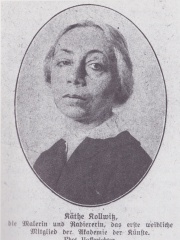
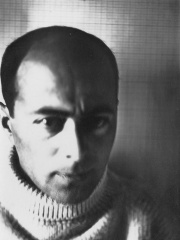
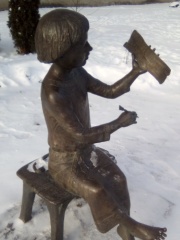
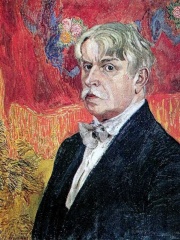
The Most Famous
ARTISTS from Russia
This page contains a list of the greatest Russian Artists. The pantheon dataset contains 125 Artists, 5 of which were born in Russia. This makes Russia the birth place of the 8th most number of Artists behind Italy, and Netherlands.
Top 5
The following people are considered by Pantheon to be the most legendary Russian Artists of all time. This list of famous Russian Artists is sorted by HPI (Historical Popularity Index), a metric that aggregates information on a biography's online popularity.

1. Käthe Kollwitz (1867 - 1945)
With an HPI of 73.55, Käthe Kollwitz is the most famous Russian Artist. Her biography has been translated into 54 different languages on wikipedia.
Käthe Kollwitz (German pronunciation: [kɛːtə kɔlvɪt͡s] born Schmidt; 8 July 1867 – 22 April 1945) was a German artist who worked with painting, printmaking (including etching, lithography and woodcuts) and sculpture. Her most famous art cycles, including The Weavers and The Peasant War, depict the effects of poverty, hunger and war on the working class. Despite the realism of her early works, her art is now more closely associated with Expressionism. Kollwitz was the first woman not only to be elected to the Prussian Academy of Arts but also to receive honorary professor status.

2. El Lissitzky (1890 - 1941)
With an HPI of 72.35, El Lissitzky is the 2nd most famous Russian Artist. His biography has been translated into 48 different languages.
El Lissitzky (Russian: Эль Лиси́цкий, born Lazar Markovich Lissitzky Russian: Ла́зарь Ма́ркович Лиси́цкий, ; 23 November [O.S. 11 November] 1890 – 30 December 1941) was a Russian and Soviet artist, active as a painter, illustrator, designer, printmaker, photographer, and architect. He was an important figure of the avant-garde, helping develop suprematism with his mentor, Kazimir Malevich, and designing numerous exhibition displays and propaganda works for the Soviet Union. Lissitzky began his career illustrating Yiddish children's books in an effort to promote Jewish culture. He started teaching at the age of 15, maintaining his teaching career for most of his life. Over the years, he taught in a variety of positions, schools, and artistic media, spreading and exchanging ideas. He took this ethic with him when he worked with Malevich in heading the suprematist art group UNOVIS, when he developed a variant suprematist series of his own, Proun, and further still in 1921, when he moved to Weimar Republic. In his remaining years he brought significant innovation and change to typography, exhibition design, photomontage, and book design, producing critically respected works and winning international acclaim for his exhibition design. This continued until his deathbed, where in 1941 he produced one of his last works – a Soviet propaganda poster rallying the people to construct more tanks for the fight against Nazi Germany.

3. Onfim (b. 1250)
With an HPI of 67.58, Onfim is the 3rd most famous Russian Artist. His biography has been translated into 23 different languages.
Onfim (Russian: Онфим; Old Novgorodian: Онѳимє, romanized: Onthime; fl. c. 1220–60), also known as Anthemius, was a boy who lived in the Russian city of Novgorod in the 13th century, sometime around 1220 or 1260. He left his notes and homework exercises scratched in soft birch bark, which was preserved in the clay soil of Novgorod. Onfim, who was most likely six or seven at the time, wrote in the East Slavic Novgorod dialect. Besides letters and syllables, he drew "battle scenes and drawings of himself and his teacher."

4. Aleksandr Golovin (1863 - 1930)
With an HPI of 56.91, Aleksandr Golovin is the 4th most famous Russian Artist. His biography has been translated into 19 different languages.
Aleksandr Yakovlevich Golovin (Russian: Алекса́ндр Я́ковлевич Голови́н, Russian pronunciation: [ɐlʲɪˈksandr ɡəlɐˈvʲin]; 1 March [O.S. 17 February] 1863 – 17 April 1930) was a Russian and Soviet decorator, painter, and stage designer. He designed productions for Sergei Diaghilev, Constantin Stanislavski, and Vsevolod Meyerhold.
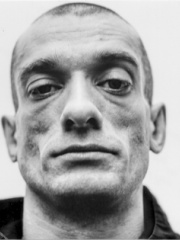
5. Petr Pavlensky (b. 1984)
With an HPI of 44.63, Petr Pavlensky is the 5th most famous Russian Artist. His biography has been translated into 15 different languages.
Pyotr (or Petr) Andreyevich Pavlensky (Russian: Пётр Андреевич Павленский; born 8 March 1984) is a Russian contemporary artist. He is known for his controversial political art performances, which he calls "events of Subject-Object Art" (previously "events of political art"). His work often involves nudity and self-mutilation. In a manner likened to ancient Cynic protest, Pavlensky makes the "mechanics of power" visible, forcing authorities to take part in his events by staging them in areas with heavy police surveillance. By doing so, "the criminal case becomes one of the layers of the artwork" and the government is "[drawn] into the process of making art".
People
Pantheon has 5 people classified as Russian artists born between 1250 and 1984. Of these 5, 1 (20.00%) of them are still alive today. The most famous living Russian artists include Petr Pavlensky. The most famous deceased Russian artists include Käthe Kollwitz, El Lissitzky, and Onfim.
Living Russian Artists
Go to all RankingsDeceased Russian Artists
Go to all RankingsKäthe Kollwitz
1867 - 1945
HPI: 73.55
El Lissitzky
1890 - 1941
HPI: 72.35
Onfim
1250 - Present
HPI: 67.58
Aleksandr Golovin
1863 - 1930
HPI: 56.91
Overlapping Lives
Which Artists were alive at the same time? This visualization shows the lifespans of the 3 most globally memorable Artists since 1700.

